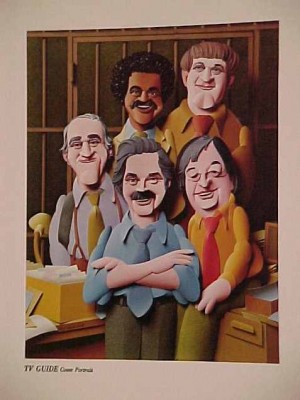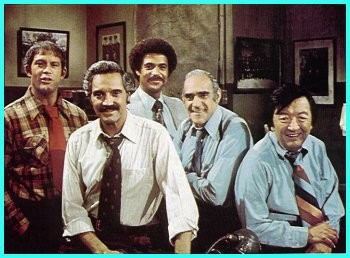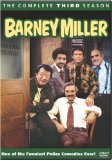| Reviews & Columns |
|
Reviews DVD TV on DVD Blu-ray 4K UHD International DVDs In Theaters Reviews by Studio Video Games Features Collector Series DVDs Easter Egg Database Interviews DVD Talk Radio Feature Articles Columns Anime Talk DVD Savant Horror DVDs The M.O.D. Squad Art House HD Talk Silent DVD
|
DVD Talk Forum |
|
|
| Resources |
|
DVD Price Search Customer Service #'s RCE Info Links |
|
Columns
|
|
|
Barney Miller - The Complete Third Season
No, Barney Miller was something like a cross between Nat Hiken's hilarious early-'60s sitcom Car 54, Where Are You? and Beckett's Waiting for Godot. Like Car 54, Barney Miller authentically captured the essence of New York's ethnic underbelly, its concerns and preoccupations, and like Waiting for Godot an absurdist, uneventful existence inside a squad room, where instead of murderers and rapists its cops were more likely to have to contend with petty criminals: a middle-aged man caught stealing ladies' underwear, a lunatic convinced he's a werewolf, a husband charged with imprisoning his wife in the toilet to keep her from voting on election day. There's a reason why, in the show's opening titles, the first thing viewers see is a garbage scow rolling past the New York skyline (including the World Trade Center).
The third season of Barney Miller, episodes from the 1976-77 season, find the series at its peak in terms of its regular cast, one that went through many changes over the show's long run. Besides takes-it-as-it-comes Barney, the show also features deadpan cop Philip K. Fish (Abe Vigoda), an old-school policeman who looks like he absent-mindedly wandered off a stage production of Detective Story; Ron Harris (Ron Glass), an upwardly mobile, black Republican and full-time narcissist; Polish-American Stanley "Wojo" Wojciehowicz (Max Gail), a well-meaning and sweet-natured but hopelessly insecure and naïve neophyte; and inveterate gambler Nick Yemana (Jack Soo, born Goro Suzuki, in San Francisco), who looks like a Japanese basset hound, and who talks like a nightclub comic at a 4:00 AM performance. Many others characters appear on a semi-regular basis, including old-fashioned Chief Inspector Frank Luger (James Gregory), who seems to think it's still 1947; and overly-analytical, sardonic Detective Dietrich (Steve Landesberg), whose non-sequiturs leave the squad room nonplussed.
Barney Miller was created by Danny Arnold (of My World and Welcome to It and That Girl fame), along with Theodore J. Flicker, best-remembered for his great satire The President's Analyst (1968). Flicker co-authored the pilot, and in so doing was created as co-creator, though his later involvement with the series after that may have been minimal. Arnold, a former editor, famously hated shooting the show "on tape before a live studio audience," as had become commonplace with '70s sitcoms like All in the Family and Lotsa Luck. But Arnold circumvented this by stubbornly shooting episodes like mini-movies: lighting and fine-tuning the writing and performances and editing of each scene one-at-a-time, studio audience be damned. Instead of shooting a half-hour episode in 45 minutes or an hour; the taping of a Barney Miller show often dragged on into the middle of the night.
The results were a sitcom like no other. It had a unique attitude of unfazed tolerance toward minor vices and raving lunatics, an acceptance of working girls and flamboyant gay couples, an attitude that would be influential more to later hour dramas like St. Elsewhere, The Practice, and ER rather than other sitcoms.
The confined nature of the show, the fact that it almost never leaves the main squad room, becomes an asset, with its stale air you can almost smell (of Marlboro reds and Nick's famously awful coffee) and a claustrophobic disorganization forcing disparate types of all races and ethnicities into close contact. In early season three shows, the men of the 12th precinct contend with a heat wave, a (smallpox) quarantine, and are stuck working a 24-hour shift because of a flu epidemic.
Season three was Abe Vigoda's last as a regular cast member: the following season his character was spun-off into a short-lived, more conventional sitcom, Fish, with the retired detective adopting five foster children, some of whom also appeared on Barney Miller. Indeed, most of the third season is a build-up to Fish's retirement. (Two side notes about Vigoda: The former Godfather actor or his agent infamously over-inflated the character's importance to the series, reportedly demanding at one point the name of the show be changed to Fish & Barney - as opposed to even Barney & Fish. For years questions about whether the actor is alive or dead has evolved into something of an iconic pop culture joke. But here he is, alive and well, right here.)
Season three guest stars include Kenneth Mars, Denise Miller, Jack DeLeon, Florence Halop, Sal Viscuso, Brett Somers, Jon Lormer, Queenie Smith, Florence Stanley, Ivor Francis, John Cassisi, June Gable, Mike Kellin, Oliver Clark, Stefan Gierasch, Michael Tucci, Howard Platt, David Clennon, Vivi Janiss, Buddy Lester, Billy Barty, Doris Roberts, James Cromwell, Phil Leeds, George Murdock, and Peggy Pope.
Video & Audio
Barney Miller - The Complete Third Season presents all 22 episodes on three single-sided, dual-layered discs, crammed together on a single plastic hub. (They don't seem to get scratched stored this way, however.) The show, being filmed on tape, is only going to look so good, but the full frame image isn't bad at all, better than I would have imagined. A mini-episode guide with plot summaries is included as an insert. There are no subtitle or alternate language options, though the disc is closed-captioned, and there are no Extra Features, a big shame as I'd bet Linden, Glass, and Gail have great stories about the show to share.
Parting Thoughts
Revisiting Barney Miller confirmed my suspicions, that I just didn't get it 30 years ago when the series was still new, and that time has been good to the men of the 12th precinct, and the series seems fresh and hip today. Highly Recommended.
Film historian Stuart Galbraith IV's latest book, The Toho Studios Story, is on sale now.
|
| Popular Reviews |
| Sponsored Links |
|
|
| Sponsored Links |
|
|
| Release List | Reviews | Shop | Newsletter | Forum | DVD Giveaways | Blu-Ray | Advertise |
|
Copyright 2024 DVDTalk.com All Rights Reserved. Legal Info, Privacy Policy, Terms of Use,
Manage Preferences,
Your Privacy Choices | |||||||
















